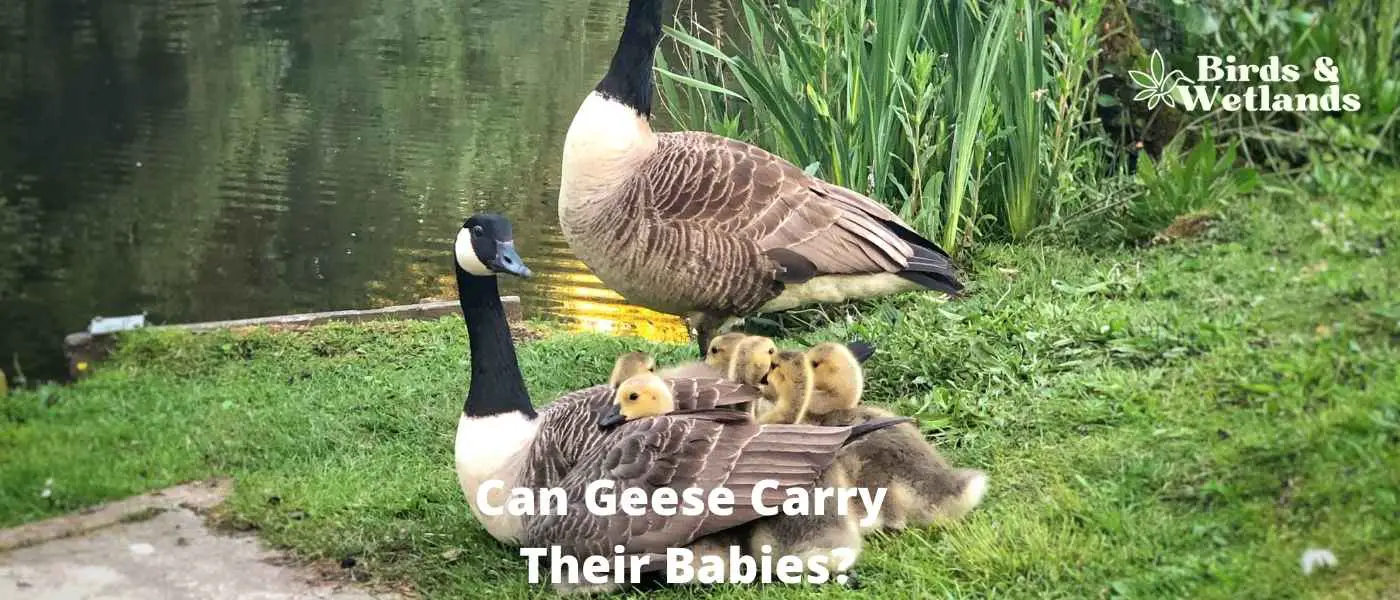Waterfowl live all over the world and can be found on every continent except Antarctica. One of the largest concentrations of waterfowl especially geese is in North America, where they are an important part of the ecosystem and are popular among birdwatchers and hunters.
Waterfowl are a family of birds that includes ducks, geese, and swans. Unlike most other bird families, waterfowl have reliably shown parental carrying on the back while swimming.
Why Does a Female Goose Carry Chicks on Her Back?
Most birds are not strong enough to carry their young. However, some large birds such as swans and storks are able to grab and toss hatchlings out of their nests.
Other birds or waterfowl such as geese and ducks carry young on their backs. Adult geese will often carry baby geese on their backs while swimming in order to keep them safe and help them avoid predators.
By doing so, the geese are able to better protect their young geese, ensure their safety and escape predators by traveling together.
This behavior is not only seen in geese but in many other waterfowl species as well. For example, mother ducks will often do the same thing with their ducklings. This helps the young ones stay together and avoid becoming separated from their mother.
When Can Goslings Learn How to Swim?
Most newly hatched babies learn how to swim immediately but some goslings learn to swim alone at about two weeks old. By this time, they have developed the necessary muscles and coordination to keep themselves afloat.
In the wild, a mother goose will help keep her gosling dry and warm. But in a brooder, there is no such protection so it’s important to not let them get soaked.
Goslings can be very curious and may want to explore everything, including the water. It’s important to provide a shallow dish of water for them to paddle in so they can get used to the sensation of being wet.
Once they are comfortable with this, you can gradually increase the depth of the water until they are able to swim well. Goslings are natural swimmers and will usually take to the water quite easily. Just be sure to supervise them at all times to prevent any accidents.
Do Canada Geese Move Their Babies?
When the Canada goslings hatch, the entire family of Canada geese moves away from the nest site on foot toward more favorable feeding areas. This trek is done entirely on foot and may involve crossing traffic and bodies of water such as rivers and ponds. The travel usually takes place during the day.
The main reason for this annual journey is to find a safe place to raise their young. While traveling, they will often stop over in areas where there is food and water available. Once they reach their destination, they will establish a new nest site and begin the cycle all over again.
Male Canada geese are forced to leave their family group and live with a group of single young males when they turn one year old. Females stay with their parents and families until they are ready to mate, which occurs in the third or fourth year of their lives.
Males begin mating with other geese at three years of age, and females begin mating when they are four years.
Conclusion on Do Adult Geese Carry Their Hatchlings
Parenting carrying is common among the waterfowl species including geese, swans, and ducks. This behavior helps parents protect their offspring from potential predators and also keep them close while foraging for food.
Both male and female goose accompany their goslings as they swim and travel in search of better feeding grounds.
FAQs about Nesting Geese
Do Canada Geese Molt?
Canadian geese are known for black head and gray-brown to dark brown body feathers. The sound of a flock of Canadian geese flying overhead is one of the most distinctive and recognizable sounds in nature which usually starts in mid to late February, depending on the climate.
But what most people don’t know is that Canada geese molt when they lose their tail feathers and ability to fly. Canadian geese molt in the summertime at the brood-rearing area, after which they are unable to fly for about six weeks.
They stay in a group during this time, relying on their young to protect them because they are vulnerable until new feathers have come in. After the adults have molted and regained their flight feathers about the same time goslings are able to fly, they start traveling in flocks again.
Do Canada Geese Return to Their Nesting Site?
The Canada goose is a migratory bird that mates for life and returns to the same nest location each year. These are heavy birds but their flight speed can reach 30 to 40 miles per hour. They form monogamous pairs and share parenting duties equally. They form family groups that stay together until the mating season.
Geese use their beaks to build nests from sticks, grass, and other materials found in their environment. The female Canada goose lays anywhere from 2-9 eggs, which she incubates for 25 to 30 days, which is the normal gestation period.
The female lays one egg every one or two days. During this time, the male goose stands guard at a short distance away so he does not attract predators. Once all the eggs hatch into cute, little goslings, both Canada geese parents will care for them until they are old enough to fend for themselves.
While Canada geese typically mate for life, if one member of a pair dies, the surviving goose will find a new mate within the same breeding season. This helps to ensure that the goose species can continue to reproduce and thrive in their environment. Canada goose is an important part of the ecosystem and plays a role in maintaining the balance of nature.
Can I Prevent Canada Geese From Nesting in My House?
Canada geese mate for life. And they usually come back to the same nesting site year after year. The female chooses her mate based on his behaviors and ability to protect her.
The birds’ nest size for their eggs can range from 12 to 40 inches in diameter and is usually bowl-shaped. It is typically made from plant material or a large mound of vegetation. They prefer an elevated area but some of the parents build nests on the ground.
But if you don’t want them on your property, here are a few things you can do:
- If you avoid trimming grasses and let shoreline vegetation grow tall, it inhibits the Canada geese’s access to the water. Canada geese seek out areas with an unobstructed view of water bodies and large expanses of mown grass nearby. This is one of the reasons why they are attracted to golf courses. However, if they can’t see the other side of the tall vegetation near the water body, they will be deterred from making a nest there. You will eventually see fewer geese at ponds and lakes. Grasses around lakes and ponds can often grow quite tall, obstructing the view of the birds and helping prevent Canada geese from nesting with their babies in your house. You can try planting aquatic vegetation such as cattails, sedges, rushes, and warm-season grasses.
- Installing barriers, such as fences, meshes, or wires, prevents Canada geese from nesting in your house. These barriers help to protect your home from damage and keep the geese away from your property. It is important to install these barriers before the geese have a chance to nest and lay egg batches, as it can be difficult to remove them once they have established a nest.
- Visual deterrents are a great way to prevent Canada geese from nesting in your house and in nearby areas. By using balloons, scarecrows, flags, and Mylar tape, you can create a visual barrier that will keep the geese away. The geese will see the deterrents and be scared away, preventing them from nesting in your yard.
- Another great way to deter Canada geese from nesting in your yard is to use a motion-activated sprinkler system. These sprinklers will turn on when the geese approach, and the noise and movement will scare them away. This is a great way to keep your yard free of geese before their nesting season without having to constantly monitor them.
- You can also use chemical repellents to deter Canada geese from nesting on your ground. These repellents will make the area around your home unappealing to the geese, and they will be less likely to nest there. However, you should always read the labels carefully and follow the directions to avoid harming yourself or the environment. Use chemical repellants approved and registered with the U.S. Environmental Protection Agency.
- Large dogs can be intimidating to Canada geese, which often prevents them from nesting near or around houses. This is beneficial, as it means that the geese are less likely to cause damage to property or leave droppings all over the place. Additionally, having a large dog around can be a great source of companionship and security.
Can I Remove the Canada Goose Nest or Eggs?
The Canada goose (Branta canadensis) and its subspecies the Giant Canada goose (Branta canadensis maxima) are federally-protected species in the United States. This means that it is illegal to disturb or damage their nest in any way, or to remove the eggs from the nest, especially during the breeding season.
Geese are federally protected under the Migratory Bird Treaty Act of 1918. This law makes it illegal to kill, harm, or harass geese, or to destroy their nests or eggs.
If you have geese nesting on your property, you should take care not to disturb the nest. You can contact your local wildlife agency for advice on how to deal with geese nesting on your property. If they are not bothering you, then you can help them by feeding them nutritious food like bananas but not carbohydrates like bread.
How Do Geese Choose Their Nesting Sites?
When Canada geese fly south for the winter, they don’t always go to the same place. Some stay in their usual territory, but others will choose a new nesting site each year.
This can sometimes lead to conflicts with humans, as the geese will sometimes choose to nest in areas that are close to people and their homes or businesses, and yes geese will attack humans if they feel threatened.
Most geese go back to their previous nesting area geese year after year. This waterfowl’s common behavior often puts them in conflict with private property owners, especially those in urban areas.

Jim Addison is an avid bird watcher and has been obsessed with the activity since he was a young boy.
He has traveled all over North America in search of new and interesting species to observe, and his detailed knowledge of the subject makes him a sought-after expert on the topic.

